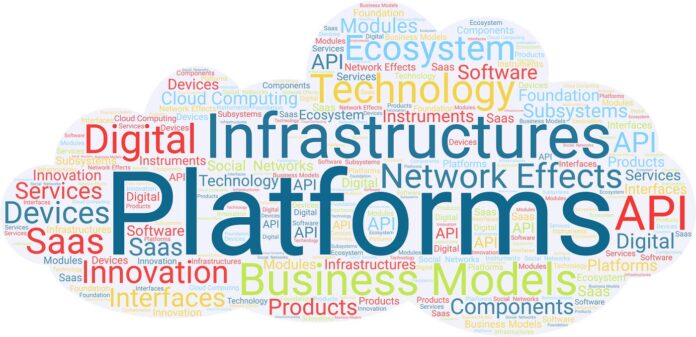In the ever-evolving digital economy, businesses are rethinking how they create value and maintain competitiveness. One of the most powerful strategies emerging from this shift is the transformation from product-centric business models to platform-based ecosystems.
What are Products?
At its core, a product is a tangible or intangible good that fulfills a specific need for a customer. Whether it’s a physical item like a smartphone, a digital product like software, or a service like consulting, products are typically created by companies and sold directly to consumers or other businesses. The key characteristic of a product is that it follows a linear value chain—manufacturers or creators build, market, and distribute the product to an end-user. In this model, the product owner controls the value creation and distribution process.
Examples of traditional product-based businesses include:
• Apple’s iPhone (a physical product)
• Microsoft Office Suite (a software product)
• Nike running shoes (consumer goods)
In these cases, value is derived from the direct consumption or ownership of the product.
What are Platforms?
A platform is a business model that enables interactions between two or more interdependent groups—usually producers and consumers. Unlike traditional products, platforms do not create direct value by themselves. Instead, they facilitate the exchange of value by enabling participants to interact, share, create, and transact with one another.
Platforms are built on network effects, meaning their value increases as more participants join and engage. For instance, as more sellers and buyers participate in an e-commerce platform like Amazon, its overall utility rises for everyone involved.
Examples of well-known platforms include:
• Uber, which connects drivers (service providers) with passengers (customers)
• Airbnb, which connects hosts with travelers
• Google Play and Apple’s App Store, which connect app developers with users
Types of Platforms
There are several types of platforms that cater to different types of interactions. Understanding these distinctions is critical when transforming a product into a platform.
1. Transaction Platforms: These platforms facilitate transactions between buyers and sellers. We have many examples f platforms available and we use them on a daily basis. Examples are Amazon, eBay, and Alibaba, which provide the infrastructure for e-commerce transactions.
2. Innovation Platforms: These platforms provide a technological foundation for third-party developers to build upon. Examples include Apple’s iOS, Android, and cloud platforms like Amazon Web Services (AWS). They enable innovation by allowing others to create products that enhance the ecosystem.
3. Content Platforms: These platforms allow users to create, share, and consume content. Examples include YouTube, TikTok, and Instagram, which focus on user-generated content to engage audiences.
4. Social Platforms: These platforms focus on interactions between users, enabling communication and networking. Facebook and LinkedIn are prime examples of social platforms.
5. Marketplace Platforms: These are platforms where buyers and sellers of goods or services interact. Examples include Etsy (handmade goods), Fiverr (freelancing services), Upwork (professional services). Jumia, Konga etc.
Product-to-Platform Transformation
The transition from a product to a platform is not merely a technological shift but a complete transformation in how value is created and delivered. We have even seen successful companies fail in this shift. A typical example is Microsoft’s Windows Mobile, which could not make the shift despite being the market leader in PC but failed in the smartphone industry, to Apple’s iOS and Google’s Android. They were faced with the chicken and egg dilemma and were unable to incentivize users from the PC to their mobile, despite acquiring Nokia.
Here is a strategic roadmap for companies looking to convert their products into platforms successfully:
1. Identify Core Product Value and Expand its Ecosystem
The first step in transitioning from a product to a platform is identifying the core value that the product already provides. Once identified, businesses should consider how this core value can be extended into a broader ecosystem. The goal is to enable others—third-party developers, partners, or consumers—to create value within that ecosystem.
Example: Apple transitioned the iPhone from being a standalone product into a platform by creating the iOS ecosystem. By opening its App Store to developers, Apple allowed third-party apps to enhance the iPhone’s value exponentially.
2. Enable Two-Sided or Multi-Sided Interactions
A platform thrives on interactions between different user groups, so businesses must shift their focus from simply delivering a product to enabling two-sided or multi-sided interactions. This means creating a space where different user groups can come together, interact, and transact.
Example: Airbnb started as a simple website for short-term accommodations. However, it transformed into a platform by enabling interactions between hosts (homeowners) and guests (travelers), thus facilitating value exchange.
3. Build Network Effects
Network effects are the backbone of any successful platform. As more users join and interact with the platform, its value increases for everyone. The key is to design the platform in a way that encourages more users to join, whether by improving the user experience, offering incentives, or providing access to a growing community.
Example: LinkedIn’s value grows as more professionals join the network, creating more opportunities for connections, job searches, and professional growth. The more users it has, the more valuable it becomes for everyone involved.
4. Create an Open, Scalable Infrastructure
To transform a product into a platform, companies need to open up their infrastructure to external participants. This means providing APIs, SDKs, and other tools that allow third parties to build on top of the platform, extending its functionality. This open approach will drive innovation and expand the range of services offered on the platform.
Example: Amazon Web Services (AWS) started as a cloud computing service that companies could use to scale their digital infrastructure. By offering an open platform, AWS enabled businesses of all sizes to innovate and build their own products and services using its infrastructure.
5. Foster Trust and Governance
As a platform owner, businesses need to ensure that interactions on the platform are trustworthy and safe. This requires building governance structures that promote fairness, security, and transparency. Trust is essential for the long-term success of a platform.
Example: eBay’s success as a marketplace platform is rooted in its robust feedback and rating system, which fosters trust between buyers and sellers. By ensuring transparency and accountability, eBay has created an environment where users feel secure in conducting transactions.
6. Monetize the Platform Ecosystem
Monetization strategies will change once a company transitions to a platform. Instead of merely selling a product, businesses can generate revenue through various models, such as transaction fees, subscription services, advertising, and partnerships. The key is to enable different users to engage in value exchanges while taking a small cut from each transaction.
Example: Uber monetizes its platform by taking a commission on each ride booked, while Spotify uses a freemium model with paid premium subscriptions.
7. Constantly Evolve the Platform
Once established, continuous innovation and improvement are vital to keeping the platform relevant, ensuring that users remain engaged and new participants join. This requires staying close to user feedback, monitoring trends, and iterating on new features.
Example: Facebook (Meta) continually evolves by introducing new features such as Marketplace, Stories, and Reels to keep users engaged and ensure it remains a central hub for social interaction.

